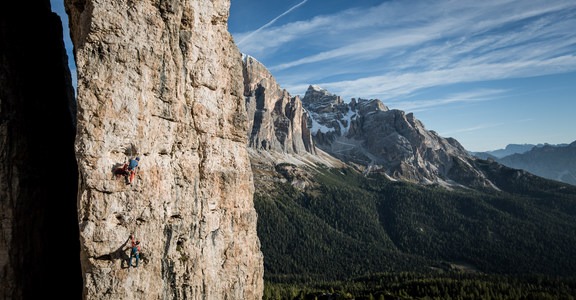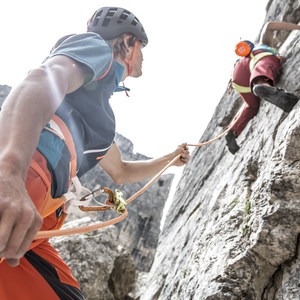First aid and rescue methods
A sunny day, compact rock and only a few more pitches to the summit. Everything is going as planned. But the situation turns on its head in seconds: A short moment of carelessness, a wrong step or an unfortunate incident can lead to a serious accident for the rope team. Small errors rarely go unpunished in the mountains. That’s why well-founded first aid expertise is of paramount importance for any mountain climber.
In this chapter, we’ll look at the theoretical foundations for lifesaving emergency techniques. This includes an emergency algorithm that first responders can use as a guide. It encompasses in-depth first-aid expertise and improvised mountain search and rescue on the rock face.
It should be noted that first aid begins during preparation. A first-aid set, bivi bag, cell phone, helmet and emergency card should be included in every climbing backpack. This ensures the responder has what the injured person needs. NOTE: The theoretical foundations are by no means a replacement for comprehensive first-aid training. All alpine climbers should have learned and practiced practical first-aid techniques on a first-aid course!
Alpine emergency situations - acting correctly
In contrast to areas with well-established infrastructure, factors specific to alpine terrain make rescues more difficult.
The first responder is therefore of lifesaving importance to the accident victim. In an emergency they are the first person to provide help and need to have mastered first-aid techniques. The following emergency algorithm clarifies important instructions for first responders.
- Taking a deep breath / taking stock: Before the responder gets to work, they should take a physical and mental step back and take a deep breath. Only if the responder is in a reasonably calm mental state can they make good decisions. When the first responder takes stock of the overall situation this allows them to recognize objective hazards, judge the accident and consider their next steps.
- Self-protection: Your own safety is paramount! In alpine climbing, the rope team will often be in precipitous terrain and at risk of falling rocks or ice and other hazards. You need to ensure your own safety before helping injured people! In a worst-case scenario, if it is too dangerous to help yourself, you should make an emergency call and wait for a professional rescue team.
- Group protection: If there are several people at the site of the accident, the safety of the group must be ensured (particularly during guided climbs). Only then can first responders go to help the accident victim.
- Secure the dangerous area: The dangerous area should be secured for the protection of yourself and others: For example the accident site can be cordoned off or visibly marked. While securing the accident scene on the rock face is often not possible or necessary, it can be necessary for accidents during ascent or descent in order to prevent further damage.
- Rescue from the dangerous area: Is the accident victim in a precipitous location? Is there a risk of falling rocks or ice? If the accident scene is at risk of objective hazards, the individual should be moved out of the dangerous area and taken a short distance to a safe location – as long as this is appropriate for the responders and does not endanger their own safety. In precipitous terrain the first responder must protect themselves and the injured person from further slips or falls. If this is not possible, the responder’s only other option is to make an emergency call and wait for a professional rescue team.
- Heavy bleeding and a state of shock: If there is heavy bleeding, this must be treated immediately with a pressure bandage. This is done before speaking to the accident victim and irrespective of whether they are conscious or unconscious. To this end, the first responder applies a pressure bandage. The responder wears gloves to protect themselves and the injured person from infections and prevent dirt getting into the wound.
Checking consciousness
The first responder should kneel down next to the injured person and speak to them. If the injured person does not react, the first responder should shake them gently and attempt to speak to them again in a louder voice.
Any time someone becomes unconscious it represents an acute risk to life. Here lifesaving emergency measures are always the number one priority!
Unresponsive victim
In the event of unconsciousness you should make an emergency call IMMEDIATELY!
Check breathing - You should constantly check breathing. See: Is the ribcage moving? Hear: Can the first responder hear the person breathing? Feel: Can they feel their breath? If they are not breathing, are breathing infrequently or are gasping for breath, you must begin resuscitation!
Perform chest compressions and artificial respiration in a ratio of 30:2 until professional help (mountain rescue / emergency doctor) has arrived or you are exhausted.
Performing chest compressions - Place the heels of your hands on the center of the chest. Use your own body weight to push the injured person’s chest down 5 to 6 centimeters. After applying pressure, release the chest. Frequency: 100 x per minute – almost twice a second.
When giving breaths, hold their nose with one hand and place the other on their chin. Tilt their head backward. Breathe in normally and then place your lips around the accident victim’s mouth and breathe out normally. You don’t need to breathe in as much air as most people think – you just need to breathe normally as you would at rest. Instead of mouth-to-mouth resuscitation, you can carry out mouth-to-nose resuscitation. Here the injured person’s mouth is closed and resuscitation is carried out via the nose.
Once they are breathing again, place them in a stable recovery position. To do this, kneel down on the valley side of the unconscious person. Lay their near-side arm at a 90-degree angle next to them. Bend their far-side leg and hold in place. Hold their far-side hand, lay the back of the hand on their cheek (the one facing toward you) and hold in place. Turn the injured person toward you at the knee. Carefully pull your own hand out from under the injured person’s head so that they are lying only on the back of their hand. Tilt their head backward. Open their mouth slightly. The mouth should be slightly lower than their stomach, so that blood or vomit can run out.
Responsive victim
Body check - The accident victim has fallen but is responsive. The first responder checks them from head to foot. The first responder works quickly, systematically and comprehensively. It is particularly important to check for bleeding, swelling, bruising, malposition and pain.
- Procedure for the body check: Head, Neck, Shoulder girdle and ribcage, Abdomen, Spinal cord, Pelvis, Arms/hands, Legs/feet.
Do you know the ill person’s symptoms? The first responder asks the ill person about their symptoms: Have they had them before / are they familiar to them? When did they last eat, drink?
-
If the ill person often has these symptoms, they will know what to do. They may have to eat/drink something, take a break or take their own emergency medicine. The first responder can provide the ill person with help or support in this regard.
-
If the ill person’s symptoms are not known or if they have forgotten emergency medicine that they now need, you should make an emergency call immediately.
Make an emergency call - If the injured person has serious injuries, cannot walk any further or if the rope partner / group is unsure, you should immediately make or delegate an emergency call. While waiting for emergency services take care of wound dressings. All necessary steps should be taken. Use a sterile bandage on the wound. Sling when necessary. Fixed dressing...etc.
Desired positioning - Is the accident victim sitting or lying comfortably? Positioning the person according to their wishes or as necessitated by the injury:
-
Upper body elevated position: Head injuries, difficulty breathing, suspected heart attack / stroke
-
Flat position: Serious hypothermia, spinal cord / thigh / pelvis injury
-
Fetal position: Abdomen pain
-
Shock position: Dry or heavily bleeding wounds, faintness / circulation problems
Heat retention
For both unresponsive and responsive victims, maintaining heat is critical. Wrap the accident victim up nice and warm and protect them from the damp and cold of the ground.
Psychological support
One of the most important techniques for the responder is psychological support – i.e. being there for the injured person, speaking and empathizing with them. Gently touching their arm or shoulder helps to ensure the injured person knows they are not alone.
Even for those that are unconscious – but still breathing – psychological support is extremely important. Some senses, such as hearing and feeling, often remain active even when the individual is unconscious. This is why verbal encouragement and physical contact are important.
The person should only be left alone as an absolute last resort, e.g. if there are only two of you and you have no cell reception. Otherwise, stay together and wait for the mountain rescue service.
Check out the full series of Safety Academy Lab Rock videos below:
- Alpine basics
- Basic equipment for every climber
- Basic equipment for groups
- Additional equipment for groups
- Storms in the mountains
- Types of rock in the Alps
- Tour planning for alpine climbing
- Packing a backpack correctly
- Rope team procedures
- Knot techniques
- Belay using bolts
- Belay methods
- Anchors
- Coiling a climbing rope
- Rappelling
- What to do in an alpine emergency
- First aid on the mountain
- Rescue techniques while alpine climbing
- Bivouacking in an emergency situation
Visit ORTOVOX’s Safety Academy Lab Rock to view the climbing tutorials in their totality and test your knowledge with their fun and interactive quizzes.
Since the company was founded in 1980 in the south of Munich, ORTOVOX has stood for the highest possible protection during alpine activities. As pioneers in the avalanche safety field, we have played a key role in the development of emergency equipment for the mountains. Innovations such as the double-frequency avalanche transceiver and Smart Antenna Technology, and also targeted training measures, continue to be valuable contributions to making mountain sports a little bit safer and to saving lives.






Comments
Sign In and share them.